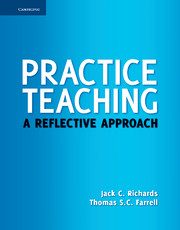Book contents
- Frontmatter
- Contents
- Introduction
- Chapter 1 Learning to Teach Through Practice Teaching
- Chapter 2 The Nature of Teacher Learning
- Chapter 3 Understanding the Teaching Context
- Chapter 4 Working With Your Cooperating Teacher
- Chapter 5 Planning Your Teaching
- Chapter 6 Teaching an Effective Language Lesson
- Chapter 7 Classroom Observation in Teaching Practice
- Chapter 8 Creating an Effective Classroom Learning Environment
- Chapter 9 Developing Learner-Centered Teaching
- Chapter 10 Classroom Discourse and Communication
- Chapter 11 Exploring Your Own Teaching
- Chapter 12 After Teaching Practice
- References
- Author Index
- Subject Index
Chapter 5 - Planning Your Teaching
Published online by Cambridge University Press: 05 October 2012
- Frontmatter
- Contents
- Introduction
- Chapter 1 Learning to Teach Through Practice Teaching
- Chapter 2 The Nature of Teacher Learning
- Chapter 3 Understanding the Teaching Context
- Chapter 4 Working With Your Cooperating Teacher
- Chapter 5 Planning Your Teaching
- Chapter 6 Teaching an Effective Language Lesson
- Chapter 7 Classroom Observation in Teaching Practice
- Chapter 8 Creating an Effective Classroom Learning Environment
- Chapter 9 Developing Learner-Centered Teaching
- Chapter 10 Classroom Discourse and Communication
- Chapter 11 Exploring Your Own Teaching
- Chapter 12 After Teaching Practice
- References
- Author Index
- Subject Index
Summary
INTRODUCTION
Planning a lesson before teaching is generally considered essential in order to teach an effective lesson and often receives considerable emphasis in teacher-training programs, although teachers vary in the nature of the planning they do and the kinds of information they include in lesson plans. Experienced teachers generally make use of less detailed lesson plans than novice teachers and often teach from a mental plan rather than a detailed written lesson plan (Richards 1998). And lesson plans often differ from the lessons teachers using them actually teach, since there are sometimes good reasons for departing from a lesson plan, depending on the way a lesson proceeds and develops (see Chapter 6). However, lesson planning is an administrative requirement of many schools, and teachers are often required to prepare yearly, term, unit, weekly, and daily lesson plans. As a student teacher you may find that the general framework and content of the course you are teaching has already been planned in some detail by the cooperating teacher. Nevertheless you will generally be required to plan for the lessons that you are going to teach or coteach so it is important to become familiar with the procedures used in lesson planning. The following comments describe student teachers' views on lesson planning:
As a student teacher, I find a detailed lesson plan to be very helpful. My cooperating teacher e-mails me a broad lesson plan every week. But it is up to me to work on the details. […]
Information
- Type
- Chapter
- Information
- Practice TeachingA Reflective Approach, pp. 55 - 71Publisher: Cambridge University PressPrint publication year: 2011
Accessibility standard: Unknown
Why this information is here
This section outlines the accessibility features of this content - including support for screen readers, full keyboard navigation and high-contrast display options. This may not be relevant for you.Accessibility Information
- 2
- Cited by
